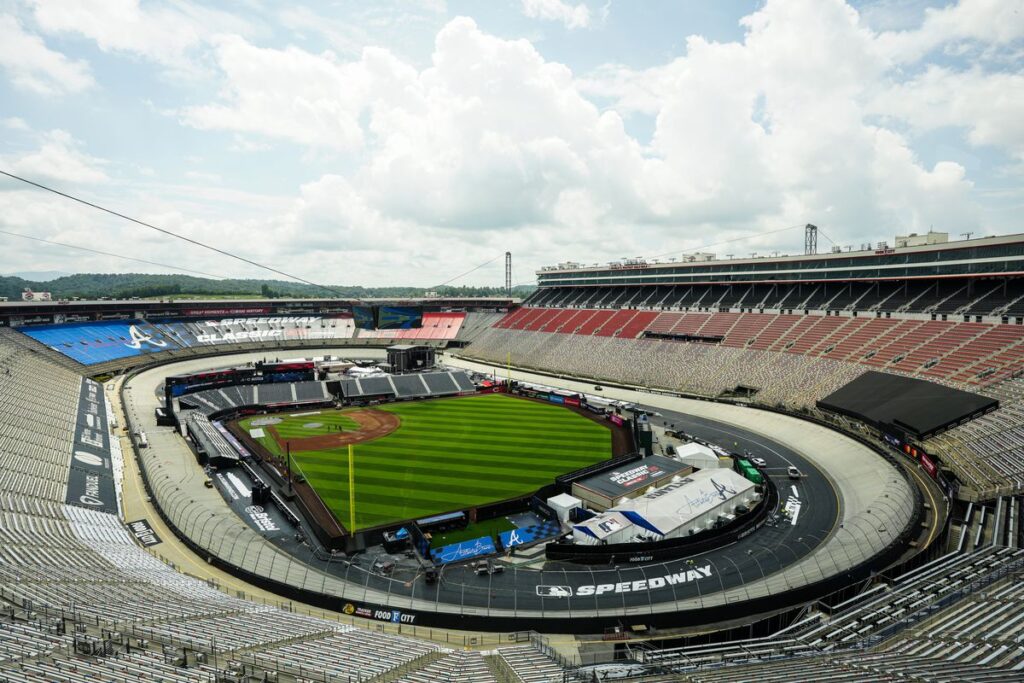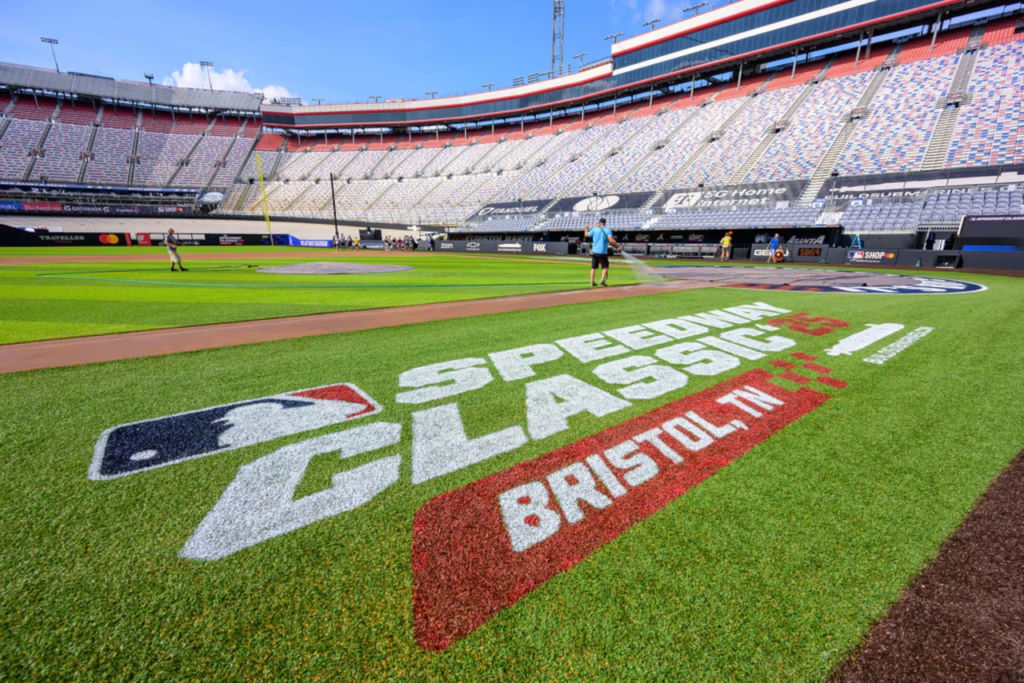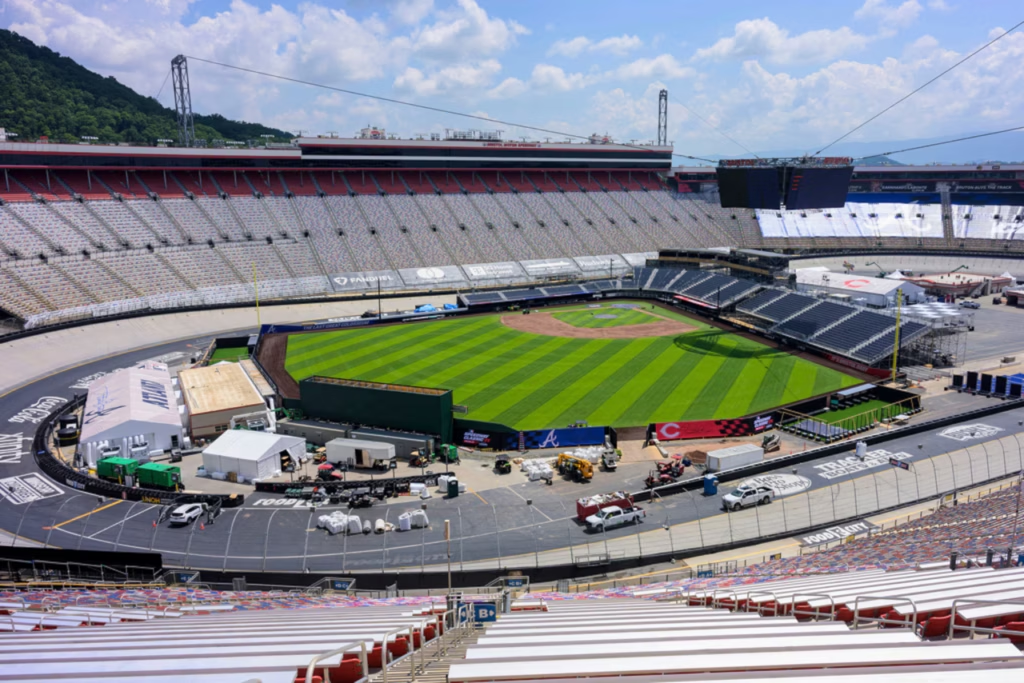The Atlanta Braves and Cincinnati Reds made history as they took the field at Bristol Motor Speedway, turning one of NASCAR’s most hallowed tracks into an open-air baseball coliseum. The MLB Speedway Classic wasn’t just a unique game—it redefined what’s possible for American sports, fusing two distinct fan cultures and industries in a breathtaking display of innovation, entertainment, and communal pride. This landmark event holds profound significance, reshaping the relationship between tradition, spectacle, and the future hopes of leagues and their fans.
🔍 Key Facts or Breaking News Details
- Date: August 2, 2025
- Location: Bristol Motor Speedway, Bristol, Tennessee
- Incident Summary: First-ever MLB regular season game staged within a NASCAR venue, as the Atlanta Braves battled the Cincinnati Reds in front of over 40,000 spectators
- Involved Parties: Atlanta Braves, Cincinnati Reds, Major League Baseball, NASCAR, Bristol Motor Speedway, national and regional sponsors
- Immediate Consequences: Overflowing sold-out crowd; surge in local tourism; live national and international audience via broadcast and streaming; significant exposure for both leagues
- Timeline of Event and Public/Legal Response:
- Early 2025: Event announcement sweeps sports media, igniting widespread buzz and speculation
- Spring/Summer 2025: Aggressive cross-industry marketing and ticket presales result in sellouts within hours; collaborative community outreach initiatives
- August 2, 2025: Flawless execution on game day, with positive critical and public reception; last-inning thriller as the Reds clinch a 5-4 victory
- Post-game: Accelerated planning for repeat events; endorsements from civic leaders; surging demand for crossover experiences among fans and sponsors

💸 Money Angle / Wealth Perspective
The financial ramifications of the MLB Speedway Classic were as groundbreaking as the event itself. From a business and economic standpoint, the Speedway Classic was a singular opportunity to leverage the strength of two iconic American brands—baseball and auto racing—against a backdrop of entertainment convergence.
Tourism and Local Economy:
The influx of visitors flooded Bristol’s hotels, restaurants, and retailers, producing a record-breaking economic windfall estimated at $40 million in regional impact. City officials cited all-time highs for tax revenue during event weekend, and local small businesses—ranging from food vendors to memorabilia shops—reported their best sales in years. Temporary job creation and overtime opportunities surged in hospitality, transportation, and security.
Sponsorships, Advertising, and Merchandising:
The Classic’s sponsorships set new records, as brands with roots in both sports (Coca-Cola, Chevrolet, Nike) battled for exclusive activation zones and co-branded promotions. Unique media packages—spanning broadcast, streaming, onsite digital displays, and influencer campaigns—generated millions in exposure value. Merchandise booths offered event-only apparel and collectibles, many of which sold out before the game even began, underscoring the market’s appetite for novelty and nostalgia.
Player and Organizational Revenue:
For athletes, contractual incentives and appearance fees tied to promotional activities boosted personal earnings, adding to the league minimums and star salaries. The Braves and Reds, as franchises, also benefited from new sponsor relationships and increased national visibility, the effects of which are expected to ripple into higher ticket sales and broader fan bases in subsequent seasons.
Media Rights and Financial Projections:
Perhaps most significant was the new standard set for media rights deals. Networks and platforms paid premiums for broadcast exclusivity, resulting in one of MLB’s highest per-game revenues for 2025. Analysts predict that similar ‘Classics’ could permanently inflate the value of nontraditional venue contracts, benefiting teams, players, cities, and media partners for years to come.
📈 Career or Performance Background
Both teams arrived in Bristol against storylines of ambition and transformation. The Atlanta Braves, anchored by their dynamic outfielder Ronald Acuña Jr.—who entered the game with 31 home runs, 90 RBIs, and an MVP campaign in full swing—were chasing another postseason berth. Their roster, featuring a blend of seasoned veterans and rising stars, symbolized consistency and adaptability.
The Cincinnati Reds, experiencing a revival behind new management and a youthful core, brought phenom Elly De La Cruz to the spotlight. De La Cruz had just weeks earlier delivered back-to-back walk-off hits, instantly winning the hearts of fans and injecting hope into the Reds’ playoff chase. Pitcher Hunter Greene, celebrated for his triple-digit fastball, arrived as one of the National League’s most talked-about arms, drawing scouts and media attention.
Both squads saw Bristol not only as a spectacle, but as a proving ground: performing under unprecedented conditions, overcoming distractions, and capturing highlights for a national audience. The game’s intense moments—Acuña’s towering home run to left, Greene’s clutch strikeouts, and De La Cruz’s dramatic late-inning double—ensured it will be cited as a milestone in both team histories.
🌟 Brand, Influence & Culture Impact
The MLB Speedway Classic delivered a branding masterpiece. MLB and NASCAR joined forces, not only blending their iconography but developing joint social and advertising initiatives. Extensive behind-the-scenes content—Instagram stories, TikTok challenges, and live streams from both ballplayers and NASCAR drivers—pulled in millions of views and introduced casual and hardcore fans alike to new athletic personas.
Cultural Confluence:
The event spurred a lively cultural conversation around the merging of two heartland American passions. Locals and travelers alike donned hats with dual logos, cheering for home runs and reminiscing about legendary races. Gender, age, and regional identities all intersected at Bristol: families arrived in RVs for weekend-long tailgates, while younger fans posted viral reaction videos and “fit checks.”
Media Conversation & Community Reaction:
National and local commentators debated everything from crowd noise comparisons to the meaning of sports spectacle in contemporary America. Bristol became a trending topic not only in sports columns but also in pop culture outlets. Fans volunteered at community engagement booths co-hosted by MLB and racing charities, demonstrating the event’s layered impact far beyond ticket sales.
Narrative and Inclusivity:
For MLB and the region, Bristol symbolized progress. Community leaders noted an increase in youth baseball interest and cross-cultural conversations between fans who, but for the Classic, may never have shared a bleacher or barbecue stand. Media narratives focused on the event as a “celebration of unity and possibility,” challenging future hosts to expand on its successes.

🔎 The Current Media Landscape of the MLB and Sports Crossover
The Classic highlighted seismic shifts in sports consumption. With national TV coverage complemented by streaming exclusives, VR-enabled ballpark tours, and social-first content from both leagues, the event became a case study in modern fan engagement.
- Multi-Screen Storytelling: Fans followed real-time stats on their phones while watching drone-cam replays on giant jumbotrons.
- Influencer Integration: Both MLB stars and NASCAR legends posted in-game content; personalities like Chipper Jones and Dale Earnhardt Jr. offered collaborative interviews and game-day takes across every platform.
- Audience Expansion: Surveys indicated an uptick in cross-generational viewership, with many NASCAR fans calling it their “first MLB game” and vice versa.
- Sponsorship Innovation: New advertising models tested NFT souvenirs and digital autograph sessions, pointing to a future where the event is a multi-sensory, always-on experience.
📜 A Historical Perspective: MLB’s & Bristol’s Journeys
Major League Baseball’s tradition of staging games in storied or unexpected locations—such as the Field of Dreams in Iowa, the Fort Bragg Game for the military, and the London Series—provided a template for the Speedway Classic, but never before had a major U.S. league inhabited a NASCAR cathedral.
For Bristol Motor Speedway, an institution since 1961, the event extended its famed legacy. The site, renowned for its night races and sonic intensity, had always pushed boundaries, once touting crowd counts greater than many Super Bowls. The Classic was its latest reinvention—a demonstration of adaptability and a reminder that even the oldest traditions can find new life.
Over time, both MLB and NASCAR have faced labor, safety, and generational change challenges. By sharing the spotlight at Bristol, they highlighted a future where collaboration—rather than siloed identity—can drive sustained relevance and excitement.
💰 Legal Context / Business Framework
Orchestrating a regular-season baseball game on a racetrack presented unprecedented contractual and legal questions. Multi-league negotiations touched every aspect—liability insurance, revenue sharing, vendor compliance, advertising rights, and field maintenance standards. Engineers devised solutions for athlete safety, adapting turf and fencing to balance baseball’s needs with the underlying contours of the speedway.
Special insurance policies were created, and event-specific waivers signed by all athletes and staff. Broadcasting contracts required custom clauses to account for joint MLB/NASCAR promotional content and synchronized commercial schedules.
The legal and operational blueprint drafted for the Speedway Classic now stands as a model for future cross-industry events, providing a framework for transparent risk assessment, revenue sharing, and intellectual property rights in collaborative spectacles.

⚖️ Comparative Analysis: Similar Incidents in Sports
Sports history is now dotted with bold venue experiments, but the Speedway Classic raised the bar. While MLB’s Field of Dreams and NHL’s Winter Classic brought nostalgia, Bristol’s fusion pushed creative and logistical boundaries. The NBA’s outdoor game in California and the NFL’s international outings found new audiences but typically lacked the cultural interplay sparked by racing and baseball’s shared southern roots.
The result was increased sponsor enthusiasm and authentic fan engagement—a sharp contrast to mixed reviews occasionally leveled at less daring events. The Classic’s hybrid marketing, community programs, and competitive game play fused to create a template for future collaborations across leagues and continents.
🔮 What the Future Holds: Career, Legal, and Brand Outlook
The overwhelming success of the Classic is already influencing decision-makers. For players, participation cements a unique place in sports lore—possibly increasing endorsement potential and marketability. Braves and Reds management see expanded regional interest and opportunities for player-driven content creation.
MLB, NASCAR, and other leagues are evaluating proposals for “Classics” in other nontraditional venues, including Talladega Superspeedway, Daytona, and even internationally recognized tracks. Analysts predict a ripple effect in how contracts are written, with multi-media appearances and hybrid event bonuses negotiated alongside traditional performance metrics.
With public response and sponsor metrics off the charts, the future could see leagues collaborating not just on special events, but through shared digital and merchandising platforms—blurring old boundaries and expanding fan communities.
👥 The Evolving Fan Experience
Bristol was designed as much for the fan as for the athlete. Onsite activities included pre-game concerts featuring country and rock icons, memorabilia fairs, and simulators that let fans “hit a home run at Bristol” or test pit crew skills. Festival food tents blended ballpark classics with regional racing fare, while family zones offered trivia, crafts, and interactive games.
Tailgating, Social Media, and Beyond:
In the parking lots, long-standing traditions mixed with discovery. NASCAR diehards swapped racing tales with out-of-town Braves and Reds backers, turning exciting game moments into instant friendships. Online, TikTok challenges—like “Best Racing/Baseball Outfit”—blew up, and livestreamed watch parties brought together thousands from around the country.
Generational Appeal:
Post-event research found generational divides bridged: teens and Gen Zers amplified moments with creative edits and memes, while older fans expressed nostalgia and pride. The event’s diversity and inclusiveness set a new standard for accessible and memorable sports experiences.
⚠️ Risks, Challenges, and Considerations
Innovation carries inherent risk, and the Speedway Classic confronted multiple challenges. Just converting a racetrack into an MLB-regulation field pushed the limits of engineering, turf science, and safety planning. Crowd logistics, weather contingencies, and emergency response protocols all required upgrades.
Brand stakes were equally high for MLB and NASCAR—had anything gone awry, the reputational and financial blowback would have been fierce. On the field, players dealt with altered sightlines, unfamiliar bounces, and new performance pressure. Ultimately, meticulous preparation turned risk into reward, but the takeaway remains: creative ambition demands rigorous execution.
🧠 Final Thoughts: The Broader Implications
The MLB Speedway Classic shines as a symbol of what’s possible when tradition and innovation work hand-in-hand. For the leagues, the event delivered concrete business wins and set fresh expectations. For players, it offered a career highlight and deeper connections to their communities. For fans—of all backgrounds—it served as proof that sports can still break new ground and inspire awe.
The legacy of Bristol goes beyond its box score. As major sports continue to face questions about relevance, reach, and reinvention, the Classic answers with resounding optimism: by embracing bold ideas and shared experiences, American sports can thrive for generations to come.
📌 The Distinct Athlete Angle
The Speedway Classic’s biggest lesson is in brand and wealth evolution. Modern athletes, by engaging boldly in crossover events, amplify their voices and unlock new financial frontiers—endorsements, media, and post-career ventures that expand their legacy. For MLB and NASCAR, the Classic is a blueprint for maximizing reach and sustaining emotional bonds with fans new and old. The power of spectacle and partnership builds not only wealth, but a richer sports culture where innovation is rewarded.
🔗 Related Reads on Distinct Athlete
- Carlos Correa Returns to Houston Astros in Blockbuster Trade
- Detroit Tigers Land Kyle Finnegan from Nationals At Trade Deadline
- Stadium Plans for Chiefs and Royals Face Major Setback
💬 Join the Conversation
If you could choose any stadium, city, or pairing of sports for a future “Classic” crossover, what would it be? How do these genre-bending events shape your view of fandom and the evolution of American sports? Share your ideas, memories, and wildest cross-sport dreams below!

